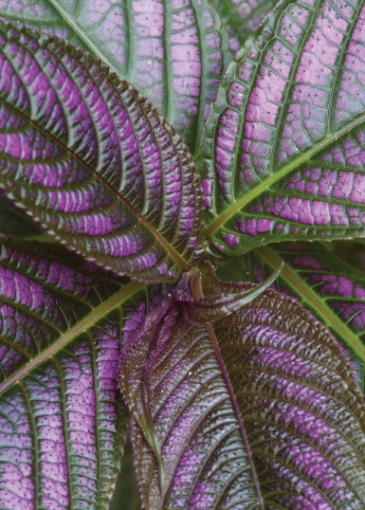Any plant that can provide constant, cheerful color through the long growing season automatically becomes a gardener’s darling, and Persian shield (Strobilanthes dyerianus) is just such a belle of the botanical ball. Rather than relying on flowers, which can be fleeting, to attract attention, this beauty is a foliage floozy that eloquently drapes itself with gorgeous leaves up to 6 inches long shimmering in iridescent shades of green, pinkish-purple and silver.
In spite of its Middle East-sounding name, Persian shield is actually native to Burma, which gives clues as to what will make it happy in a garden here. Heat and humidity are two things Southeast Asia and the Southeast U.S. have in common during the late spring and summer, and Persian shield likes both. But, being a tender broadleaf evergreen rated for USDA Zones 9 and 10, it is usually grown as an annual in this region, since it won’t survive our typical winters outside.
Morning sun will help intensify leaf colors, but too much of ol’ Sol in the scorch of the afternoon will cause this pretty to suffer, so filtered shade later in the day is recommended.
Persian shield can tolerate some drought, but it grows better in a planting site that has been enriched with such moisture-retaining ingredients as quality commercial top soil or compost. Adding these organic improvements will also fluff the growing ground up and help prevent constant soggy conditions that can cause problems for this plant in the form of root rot.
Now, to flop or not to flop, that is the question. Persian shield can grow up to 3 feet tall but has rather soft limbs, so it could topple over and spread outward rather than reach for the sky and stretch upward. For some gardeners, this makes for an expressive, vibrant flow of multicolored flora across a garden bed. For other backyard growers, it looks like a drunken plant.
To tame Persian shield’s tendency to teeter, simply pinch back its branch tips once or twice early in the growing season. This will encourage a thicker, fuller plant with shorter stems that are less likely to instigate any stagger.
Persian shield can be used as a houseplant, but its humidity requirement is usually not met in the dry air common to most homes, so misting the leaves three or four times a week is about the only way to keep it close to happy indoors.
For all its fanciness, Persian shield will not be that hard to find this spring. From big box garden centers to local nurseries, this popular plant will be easy to spot and tough to resist!
L.A. Jackson is the former editor of Carolina Gardener Magazine. Want to ask L.A. a question about your garden? Contact him by email at lajackson1@gmail.com.
To Do in the Garden
May
- Want the best production of fancy foliage from caladiums? Just remember that caladiums need generous amounts of water and fertilizer on a regular basis in order to continue producing bright new leaves through the growing season.
- Scented geraniums are at their best when they are in the way — in other words, place them at the front of a border, at the corner of a path or close to a doorway where passersby will brush up against them, releasing the plants’ sensational aromas.
- House plants outside for a summer vacation? Keep them slightly shaded so intense sun rays won’t burn tender foliage. Also, use a diluted solution of liquid fertilizer rather than granular nutrients because moisture in potted plantings quickly evaporates outdoors, and dry fertilizer in dry soil is root burn waiting to happen.
- A great weed block to combine with organic mulches is a layer of three to four pages of newspaper. Placed on the ground first and then covered with mulch, this paper barrier will prevent many weeds from popping up for at least one growing season before decomposing.
- Haven’t started your veggie patch yet? May is still a prime time to fill your edible garden with such delectable summer delights as tomatoes, beans, peppers, okra, squash, cucumbers, eggplants and watermelons.
- Watering the vegetable garden is, of course, a necessary chore when the rains don’t come, but keep an especially close watch on the moisture needs of radishes, cucumbers and onions. Failure to water these three root crops on a regular basis will result in bad-tasting radishes, bitter cucumbers and puny-sized onions.
 Timely Tip
Timely Tip
Want to try your hand at growing gladioli this year? Now that the soil has warmed up, it is time to get those gladiolus corms in the ground!
Pick a well-draining site in full sun and, for more flower power this summer, mix in a time-release bulb fertilizer at planting time. The corms should be planted about 5 inches deep and 6 inches apart.
Glads don’t perform well during dry times, so add a 3-inch layer of organic mulch to help conserve moisture and water weekly, if necessary.
Also, keep in mind that the taller (3 feet plus) cultivars can be toppled by strong winds, so as a precaution, consider adding support stakes to each hole at planting time.







